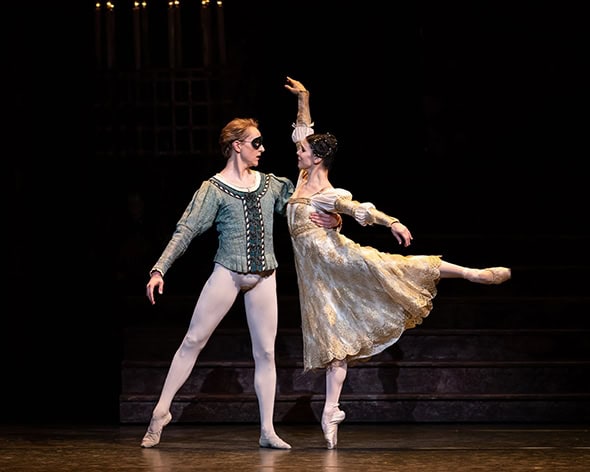Natalia Osipova in MacMillan’s Romeo and Juliet at Covent Garden
Posted: May 26th, 2019 | Author: Nicholas Minns & Caterina Albano | Filed under: Performance | Tags: Christopher Saunders, Claire Calvert, David Hallberg, Helen Crawford, Itziar Mendizabal, James Hay, Julie Lincoln, Mayara Magri, Natalia Osipova, Nicholas Georgiadis, Pavel Sorokin, Romeo and Juliet, Ryoichi Hirano, Sir Kenneth MacMillan, Tomas Mock, Tristan Dyer, Valentino Zucchetti | Comments Off on Natalia Osipova in MacMillan’s Romeo and Juliet at Covent GardenThe Royal Ballet, Romeo and Juliet, Royal Opera House, May 22

Where are the great ballet partnerships of our time? Natalia Osipova is in need of one and the Royal Ballet doesn’t seem able to oblige; it’s as if her name alone is enough to fill the house, which on the evidence of this evening it is. But a ballet like Kenneth MacMillan’s Romeo and Juliet is not about one name but two, ideally in a partnership we can believe in. Never once in three acts does guest artist David Hallberg’s Romeo convince us he is in love with Osipova’s Juliet, let alone that he is willing to die for her. That leaves Osipova in the position of emotional orphan; she has to make it up herself and is only half successful. MacMillan choreographed steps as expressions of emotion; Hallberg dances his steps in a fury of effort but nothing transpires emotionally while his gait and demeanour have not sloughed off the tropes of a romantic prince. Once he flees Verona in Act III, however, Osipova owns the entire stage because she is not constrained by anything but her wilfulness and a sleeping potion. Her frenetic indecision echoes the childlike effusion of her first entrance with Helen Crawford’s (rather too youthful) nurse and the intransigence of her refusal to accept Tomas Mock’s Paris. As with all her classical roles, you can read her from the back of the house, but when it comes to MacMillan’s central love duets on which the entire emotional force of the ballet rests she is muted by the lack of chemistry with her partner. If nothing exceptional is created by the improbable union of these two lovers, what can possibly unite the Montagues and the Capulets? Although MacMillan ends his ballet in the tomb, he leaves the aftershock with his audience. In a sense we take on the role of Shakepeare’s two warring families to ‘Go hence, to have more talk of these sad things’. Without that catalyst the star-cross’d lovers are uncross’d and we are cheated of the cathartic experience of the love story; it’s just an evening at the Royal Opera House watching names doing steps to lovely music.
Romeo’s two mates, the mischievous Mercutio (James Hay) and the more level-headed Benvolio (Tristan Dyer) find themselves in a similar dilemma to Juliet’s. Without Romeo’s full-blooded participation they become a polite trio of gatecrashers to the ball that is only distinguishable from the assembled nobles by their masks and their choreographic exploits. Hay in particular shines in his variations but his interpretation is not sufficiently defined with endearing impudence for us to feel his loss — and to understand Romeo’s — when he is killed at the hand of Ryoichi Hirano’s Tybalt (who could do with a little road rage).
When the causal relationships between the major figures and events in the ballet break down like this the tragedy loses its traction and the story just continues on autopilot until all the protagonists are dead and the curtain falls. It is the responsibility of the staging to take back control but Julie Lincoln and Christopher Saunders seem not to have had much success this evening. At least MacMillan’s crowd scenes keep the production going: the bustle of the townspeople, the tradesmen, the conspicuous harlots (Itziar Mendizabal, Claire Calvert and Mayara Magri) and mandolin dancers led by Valentino Zucchetti are all very much alive. But for all the financial resources available to the company — including the dozen or so sponsors and supporters listed in the program for the run of Romeo and Juliet — this is a production that lacks the care and attention to detail that the Royal Ballet should be devoting to the maintenance of its classical repertoire.
The set is a reworking by Nicholas Georgiadis of his original designs for the 1965 production in which MacMillan had wanted a realistic Verona. Georgiadis, who died soon after completing this makeover in 2001, did not have MacMillan on hand to guide him; his revised Verona is an abstracted framework, with the famous balcony looking more like the upper floor of a building site than the quattrocento palace it once was. It’s perhaps a disadvantage to remember the original design as the ballet’s spatial qualities were contained within it; the volumes here are less well defined.
Definition is also a problem in certain passages for the orchestra under the baton of Pavel Sorokin. It is possibly just an off evening all round, but with Osipova as Juliet this should have been an event to celebrate.